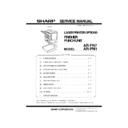Sharp AR-PN1 Service Manual ▷ View online
2-34
COPYRIGHT © 2001 CANON INC.
2000 2000 2000 2000
CANON SADDLE FINISHER G1 REV.0 MAR. 2001
CHAPTER 2 OUTLINE OF OPERATION
Stapling Operation Sequence
Rear 1-point Stapling of 2 Sheets
Rear 1-point Stapling of 2 Sheets
F02-304-07
Host machine delivery signal
Start signal
Inlet sensor (PI1)
Processing tray sensor
(PI6)
(PI6)
Feed motor (M1)
Delivery motor (M3)
Paddle motor (M2)
Paddle home position
sensor (PI2)
sensor (PI2)
Swing guide home
position sensor (PI3)
position sensor (PI3)
Stapler safety switch
(MS3)
(MS3)
Alignment motor (front)
(M4)
(M4)
Aligning plate home position
sensor (front) (PI4)
sensor (front) (PI4)
Staple/fold motor
(M7)
(M7)
Staple home position
sensor (PI19)
sensor (PI19)
CW rotation
CCW rotation
Delivery belt home
position sensor (PI7)
position sensor (PI7)
360msec
???
10msec
20msec
360msec
Staple
Chap02.p65
3/28/01, 12:18 PM
34
2-35
COPYRIGHT © 2001 CANON INC.
2000 2000 2000 2000
CANON SADDLE FINISHER G1 REV.0 MAR. 2001
CHAPTER 2 OUTLINE OF OPERATION
4 Delivery Tray Operation
4.1 Outline
The machine has a delivery tray in the finisher unit and a bind tray in the saddle unit.
The bind tray in the saddle unit is of the fixed type and all the folded paper stacks are de-
The bind tray in the saddle unit is of the fixed type and all the folded paper stacks are de-
livered to this tray. This tray has a bind tray sensor (PI13) to detect presence/absence of pa-
per.
per.
The delivery tray in the finisher unit is moved up and down using a shift motor (M6).
The finisher has a tray paper sensor (PI8) to detect presence/absence of paper on the stack
The finisher has a tray paper sensor (PI8) to detect presence/absence of paper on the stack
tray.
The home position sensor of the delivery tray is detected by the paper surface sensor
(PI19). When paper has already been stacked on the delivery tray, the home position is on
the top surface of the stacked paper. When paper has not yet been stacked on the delivery
tray, the home position is at the position where the edge of the delivery tray is detected. At
power-on, the finisher controller PCB drives the shift motor (M6) to return the delivery tray
to the home position.
the top surface of the stacked paper. When paper has not yet been stacked on the delivery
tray, the home position is at the position where the edge of the delivery tray is detected. At
power-on, the finisher controller PCB drives the shift motor (M6) to return the delivery tray
to the home position.
When the paper coming from the processing tray is stacked on the delivery tray, the shift
motor is driven a specified number of pulses, causing the delivery tray to descend. Clock
pulses are detected by the shift motor clock sensor (PI17). Then, the delivery tray returns to
the home position for the next stacking operation.
pulses are detected by the shift motor clock sensor (PI17). Then, the delivery tray returns to
the home position for the next stacking operation.
The upper limit of the delivery tray is detected by the shift upper limit sensor (PI15).
When the shift upper limit sensor (PI15) is turned ON, the finisher controller PCB stops the
shift motor (M6) that is ascending.
shift motor (M6) that is ascending.
The lower limit of the delivery tray is detected by the shift lower limit sensor (PI16).
When the shift lower limit sensor (PI16) is turned ON, the finisher controller PCB stops the
shift motor (M6) that is descending.
shift motor (M6) that is descending.
The finisher unit has a full stack sensor (PI24) to detect overstacking of large-size or
mixed paper according to the stack height.
Chap02.p65
3/28/01, 12:07 PM
35
2-36
COPYRIGHT © 2001 CANON INC.
2000 2000 2000 2000
CANON SADDLE FINISHER G1 REV.0 MAR. 2001
CHAPTER 2 OUTLINE OF OPERATION
F02-401-01
Tray paper sensor (PI8)
Shift motor (M6)
Shift motor clock sensor
(PI17)
Shift lower limit sensor
(PI16)
Full stack sensor (PI24)
Shift upper limit sensor
(PI15)
Delivery tray
Paper surface sensor (PI9)
Edge
Chap02.p65
3/28/01, 12:07 PM
36
2-37
COPYRIGHT © 2001 CANON INC.
2000 2000 2000 2000
CANON SADDLE FINISHER G1 REV.0 MAR. 2001
CHAPTER 2 OUTLINE OF OPERATION
5 Saddle Unit
5.1 Basic Operations
5.1.1 Outline
The machine stitches a stack of sheets (middle 2-point), then folds the stack in two in the
finisher. These operations are controlled by the finisher controller PCB.
The finisher controller PCB is controlled by the commands from the host machine.
Chap02.p65
3/28/01, 12:07 PM
37
Click on the first or last page to see other AR-PN1 service manuals if exist.

